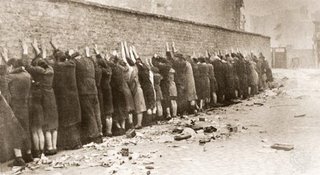
"On January 18, 1943, the first instance of armed insurgency occurred when the Germans started the second expulsion of the Jews. The expulsion stopped after four days and the ŻOB and ŻZW insurgent organizations took control of the Ghetto, building dozens of fighting posts and killing Jews they considered to be Nazi collaborators, including Jewish police officers and Gestapo agents.[2]
[edit] Opposing forces
As the frustrated Germans diverted additional resources to end the standoff, during the next three months all inhabitants of the Ghetto prepared for what they realized would be their final fight. Hundreds of camouflaged bunker shelters were dug under the houses (including 618 air raid shelters), most connected through the sewage system and linked up with the central water supply and electricity. The Ghetto fighters were armed with pistols and revolvers, few rifles and one machine gun (three heavy machine guns according to some sources). They had little ammunition, and relied heavily on improvised explosive devices and incendiary bottles; some more weapons were supplied through the uprising, or captured from the Germans. The Ghetto territory was divided into two military districts; each organization was responsible for its district.
Support from outside the Ghetto was limited, but Polish Resistance units from Armia Krajowa (AK)[3] and Communist Gwardia Ludowa[4] attacked German sentry units near the ghetto walls and attempted to smuggle weapons and ammunition inside. AK engaged the Germans between April 19 and April 23 at different locations outside the walls attempting to breach the ghetto.[3] One Polish unit from AK, namely Państwowy Korpus Bezpieczeństwa under the command of Henryk Iwański, even fought inside the Ghetto together with ŻZW and then retreated together to the so-called "Aryan side". AK disseminated information and appeals to help the Jews in the ghetto, both in Poland and via radio transmissions informing the Allies.[3] Several partisans of ŻOB and part of the command structure with help from the Poles managed escape via canals.[3] Though Iwański's action was the most famous, it was just one of many actions by the Polish resistance to help the Jews.[5]
However, in the end the combined efforts of the Polish and Jewish resistance fighters proved to be not enough against the full force of the Nazi war machine. The Germans eventually committed an averaged daily force of 2,054 soldiers and 36 officers, including 821 Waffen SS Panzergrenadier troops {consisting of five SS Reserve and Training Battalions and one SS Cavalry Reserve and Training Battalion} and 363 Polish Navy-Blue Policemen who had been ordered by Germans to cordon the walls of the Ghetto.[6] The other forces were drawn from SS Ordnungspolizei (Orpo) police regiments {battalions from 22th and 23th}, SS Sicherheitsdienst (SD) security service, one Battalion apeice from two Wehrmacht railroad combat engineers regiments, a battery of Wehrmacht light artillery, a battalion of Ukrainian Trawniki-Männer from the SS Final Solution training camp Trawniki, Lithuanian and Latvian auxiliary policemen (Askaris), and technical emergency corps as well as Polish fire brigade personnel. Their support weapons included armoured fighting vehicles, combat gasses, flamethrowers, aircraft, tanks and artillery."
When the American stormtroopers came to disarm the citizens of New Orleans, some fought back, but were pummeled, arrested, then taken to hospitals.
Would you fight for your right as strongly as the grandmothers who were beaten into submission?
No comments:
Post a Comment